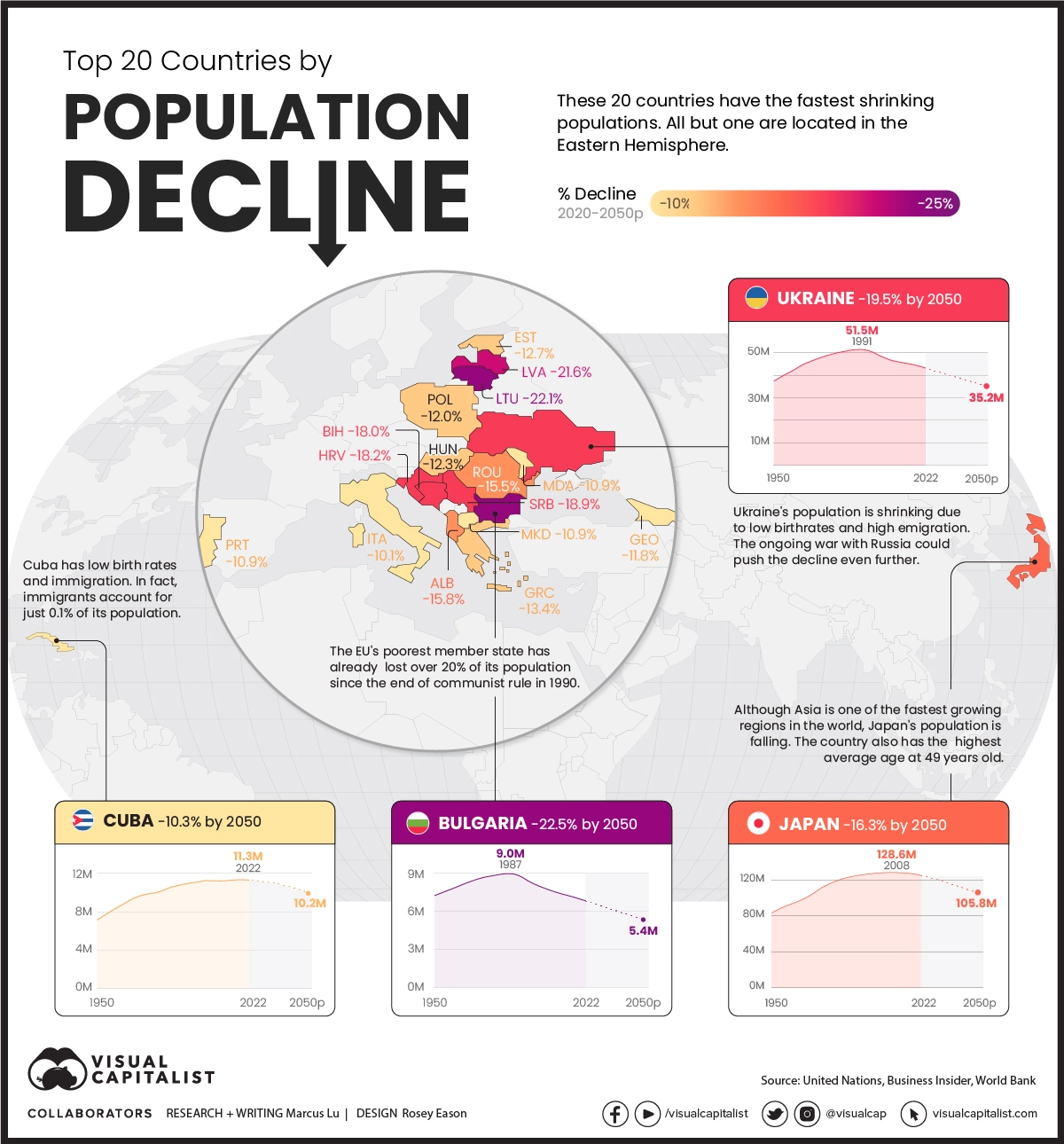DEMOGRAPHICSRanked: The 20 Countries With the Fastest Declining PopulationsPublished 2 weeks ago on July 21, 2022
By Marcus Lu
Graphics/Design:
Rosey Eason
Tweet
Share
Share
Reddit
Email
Population decline by country
▼ Use This Visualization
Visualizing Population Decline by Country
Since the mid-1900s, the global population has followed a steep upwards trajectory.
While much of this growth has been concentrated in China and India, researchers expect the next wave of growth to occur in Africa. As of 2019, for example, the average woman in Niger is having over six children in her lifetime.
At the opposite end of this spectrum are a number of countries that appear to be shrinking from a population perspective. To shed some light on this somewhat surprising trend, we’ve visualized the top 20 countries by population decline.
The Top 20
The following table ranks countries by their rate of population decline, based on projected rate of change between 2020 and 2050 and using data from the United Nations.
Rank Country Decline 2020-2050
1 
2 
3 
4 
5 
6 
7 
8 
9 
10 
PreviousNext
Many of these countries are located in or near Eastern Europe, for reasons we’ll discuss below.
The first issue is birth rates, which according to the Peterson Institute for International Economics (PIIE), have fallen since the collapse of the Soviet Union. Across the region, the average number of children per woman fell from 2.1 in 1988 to 1.2 by 1998.
Birth rates have recovered slightly since then, but are not enough to offset deaths and emigration, which refers to citizens leaving their country to live elsewhere.
Eastern Europe saw several waves of emigration following the European Union’s (EU) border expansions in 2004 and 2007. The PIIE reports that by 2016, 6.3 million Eastern Europeans resided in other EU states.
The Outliers
There are two geographical outliers in this dataset which sit on either side of Europe.
Japan
The first is Japan, where birth rates have fallen continuously since 1970. It wasn’t until 2010, however, that the country’s overall population began to shrink.
By the numbers, the situation appears dire. In 2021, 811,604 babies were born in Japan, while 1.44 million people died. As a result of its low birth rates, the island nation also has the world’s highest average age at 49 years old.
The Japanese government has introduced various social programs to make having kids more appealing, but these don’t appear to be getting to the root of the problem. For deeper insight into Japan’s low birthrates, it’s worth reading this article by The Atlantic.
Cuba
The second country is Cuba, and it’s the only one not located within the Eastern Hemisphere. Cuba’s fertility rate of 1.7 children per woman is the lowest in the Latin American region. It can be compared to countries like Mexico (2.2), Paraguay (2.5), and Guatemala (3.0).
Cuba’s immigration is also incredibly low compared to its neighboring countries. According to the International Organization for Migration, immigrants account for just 0.1% of its total population.
Subscribe to Visual Capitalist
Subscribe to our free newsletter and get your mind blown on a daily basis:
Your email address
Sign up
RELATED TOPICS:TrendsDemographicsJapanMapsPopulation GrowthEuropePopulationPopulation Decline
DON’T MISSIconic Infographic Map Compares the World’s Mountains and RiversCLICK FOR COMMENTSYOU MAY ALSO LIKE
Who’s Still Buying Fossil Fuels From Russia?
World Happiness Levels in 2022
Mapped: Global Happiness Levels in 2022
ukraine international trade
Visualizing Ukraine’s Top Trading Partners and Products
ukraine map explainer
Map Explainer: Key Facts About Ukraine
Visualizing The World’s Biggest Rice Producers Share
Visualizing the World’s Biggest Rice Producers
Mapping Corruption in Countries Around the World Share
Mapped: Corruption in Countries Around the World
DEMOGRAPHICSVisualizing the World’s Most Popular Religions
This graphic shows a breakdown of the world’s major religions, and how much of the global population follows each one.
green check mark icon CREATOR PROGRAM
Published 1 month ago on June 20, 2022
By
Carmen Ang
World’s Religions
Visualizing the World’s Most Popular Religions
According to some estimates, there are over 4,000 religions, faiths groups, and denominations that exist around the world today. Researchers and academics generally categorize the world’s religions into five major groups: Christianity, Islam, Buddhism, Hinduism, and Judaism.
This graphic by Chit Chart visualizes the most popular religions around the world, using the latest available data from Index Mundi’s world demographics.
In addition to the five major religious groups, the graphic includes two more categories: one for a collective of Folk religions and another for people who are unaffiliated with a religion.
The Religions with the Most Followers
Although the number of people who follow a religion has decreased in recent decades, 82.8% of the global population still identifies with one of the world’s major religions.
Here’s a breakdown of the most popular religions, ranked by their following as a percentage of the world’s population:
Rank Religion % of World’s Population
1 Christian 31.4%
2 Muslim 23.2%
3 Unaffiliated 16.4%
4 Hindu 15.0%
5 Buddhist 7.1%
6 Folk Religions 5.9%
7 Jewish 0.2%
8 Other 0.8%
Christianity has the largest following with approximately 31% of the global population. Muslims make up the second-largest religious group, accounting for 23.2% of the world’s population.
Roughly 16.4% of the global population is unaffiliated with a religion. This figure exceeds the percentage of people who identify with Hinduism (15%), Buddhism (7.1%), Folk Religions (5.9%), or Judaism (0.2%).
The World’s Religions from Oldest to Newest
Hinduism is considered the oldest religion in the world, originating in the Indus River Valley (modern-day Pakistan) circa 7000 BCE.
While Judaism came after Hinduism, it is thought to be the oldest of the three monotheistic Abrahamic faiths, making it older than Christianity and Islam.
It began circa 2000 BCE in the Southern Levant (modern-day Israel, Palestine, and Jordan). By contrast, Christianity was founded in the 1st century and began as a movement within Judaism.
Scholars typically date the creation of Islam to the 7th century, making it the youngest of the world’s major religions on this list. Islam was established in Mecca (modern-day Saudi-Arabia).
One religion that’s not included on this list is Sikhism. Founded in the late 15th century, it’s relatively new, especially compared to other religions like Hinduism or Judaism. Yet, despite being new, Sikhism has a large following—according to some estimates, there are over 25 million Sikhs worldwide.
What are Folk Religions?
A folk religion is defined as an ethnic or cultural practice that exists outside the theological doctrine of organized religions.
Lacking sacred texts, Folk religions are more concerned with spirituality than rituals or rites. Examples of Folk religions include Native American traditions, Chinese folk religions, and traditional African religions.
Since Folk religions are less institutionalized, they are especially challenging to measure and often excluded from surveys. With that said, an estimated 5.9% of the global population (approximately 430 million people) practice a Folk religion.
The Fastest-Growing Religions
While Islam is the newest of the big five religions, it’s currently the world’s fastest-growing one too. For context, here’s the estimated percent change among the seven religion categories, between 2015 and 2060:
Rank Religious Group Est. % change in population size (2015-2060)
1 Muslims 70%
2 Christians 34%
3 Hindus 27%
4 Jews 15%
5 Folk religions 5%
6 Unaffiliated 3%
7 Buddhists -7%
Islam’s rapid growth means it may surpass Christianity as the world’s largest religion within the next half-century. What’s causing this growth?
According to Pew Research Center, the main reason is simply demographics—on average, Muslim women have 2.9 children, which the average of all non-Muslims is 2.2.
Muslims are also concentrated in Africa and the Middle East, the two regions predicted to have the highest population increases in the next few decades.
CONTINUE READINGDEMOGRAPHICSMapped: A Decade of Population Growth and Decline in U.S. Counties
This map shows which counties in the U.S. have seen the most growth, and which places have seen their populations dwindle in the last 10 years.
Published 2 months ago on June 16, 2022
By
Nick Routley
A Decade of Population Growth and Decline in U.S. Counties
There are a number of factors that determine how much a region’s population changes.
If an area sees a high number of migrants, along with a strong birth rate and low death rate, then its population is bound to increase over time. On the flip side, if more people are leaving the area than coming in, and the region’s birth rate is low, then its population will likely decline.
Which areas in the United States are seeing the most growth, and which places are seeing their populations dwindle?
This map, using data from the U.S. Census Bureau, shows a decade of population movement across U.S. counties, painting a detailed picture of U.S. population growth between 2010 and 2020.
Counties With The Biggest Population Growth from 2010-2020
To calculate population estimates for each county, the U.S. Census Bureau does the following calculations:
A county’s base population → plus births → minus deaths → plus migration = new population estimate
From 2010 to 2020, Maricopa County in Arizona saw the highest increase in its population estimate. Over a decade, the county gained 753,898 residents. Below are the counties that saw the biggest increases in population:
Rank County Point of Reference State Pop. Growth (2010–2020)
#1 Maricopa County Phoenix, Scottsdale Arizona +753,898
#2 Harris County Houston Texas +630,711
#3 Clark County Las Vegas Nevada +363,323
#4 King County Seattle Washington +335,884
#5 Tarrant County Fort Worth, Arlington Texas +305,180
#6 Bexar County San Antonio Texas +303,982
#7 Riverside County Riverside, Palm Springs California +287,626
#8 Collin County Plano Texas +284,967
#9 Travis County Austin Texas +270,111
#10 Hillsborough County Tampa Florida +264,446
Phoenix and surrounding areas grew faster than any other major city in the country. The region’s sunny climate and amenities are popular with retirees, but another draw is housing affordability. Families from more expensive markets—California in particular—are moving to the city in droves. This is a trend that spilled over into the pandemic era as more people moved into remote and hybrid work situations.
Texas counties saw a lot of growth as well, with five of the top 10 gainers located in the state of Texas. A big draw for Texas is its relatively affordable housing market. In 2021, average home prices in the state stood at $172,500—$53,310 below the national average.
Counties With The Biggest Population Drops from 2010-2020
On the opposite end of the spectrum, here’s a look at the top 10 counties that saw the biggest declines in their populations over the decade:
Rank County Point of Reference State Pop. Growth (2010–2020)
#1 Cook County Chicago Illinois -90,693
#2 Wayne County Detroit Michigan -74,224
#3 Cuyahoga County Cleveland Ohio -50,220
#4 Genesee County Flint Michigan -20,165
#5 Suffolk County Long Island New York -20,064
#6 Caddo Parish Shreveport Louisiana -18,173
#7 Westmoreland County Murrysville Pennsylvania -17,942
#8 Hinds County Jackson Mississippi -17,751
#9 Kanawha County Charleston West Virginia -16,672
#10 Cambria County Johnstown Pennsylvania -14,786
The largest drops happened in counties along the Great Lakes, including Cook County (which includes the city of Chicago) and Wayne County (which includes the city of Detroit).
For many of these counties, particularly those in America’s “Rust Belt”, population drops over this period were a continuation of decades-long trends. Wayne County is an extreme example of this trend. From 1970 to 2020, the area lost one-third of its population.
U.S. Population Growth in Percentage Terms (2010-2020)
While the map above is great at showing where the greatest number of Americans migrated, it downplays big changes in counties with smaller populations.
For example, McKenzie County in North Dakota, with a 2020 population of just 15,242, was the fastest-growing U.S. county over the past decade. The county’s 138% increase was driven primarily by the Bakken oil boom in the area. High-growth counties in Texas also grew as new sources of energy were extracted in rural areas.
The nation’s counties are evenly divided between population increase and decline, and clear patterns emerge.
population changes in u.s. counties (%)
Pandemic Population Changes
More recent population changes reflect longer-term trends. During the COVID-19 pandemic, many of the counties that saw the strongest population increases were located in high-growth states like Florida and Texas.
Below are the 20 counties that grew the most from 2020 to 2021.
Rank County Point of Reference State Pop. Growth (2020–2021)
#1 Maricopa County Phoenix Arizona +58,246
#2 Collin County Plano Texas +36,313
#3 Riverside County Riverside, Palm Springs California +35,631
#4 Fort Bend County Sugar Land Texas +29,895
#5 Williamson County Georgetown Texas +27,760
#6 Denton County Denton Texas +27,747
#7 Polk County Lakeland Florida +24,287
#8 Montgomery County The Woodlands Texas +23,948
#9 Lee County Fort Myers Florida +23,297
#10 Utah County Provo Utah +21,843
Showing 1 to 10 of 20 entriesPreviousNext
Many of these counties are located next to large cities, reflecting a shift to the suburbs and larger living spaces. However, as COVID-19 restrictions ease, and the pandemic housing boom tapers off due to rising interest rates, it remains to be seen whether the suburban shift will continue, or if people begin to migrate back to city centers.
CONTINUE READING
SUBSCRIBE
Join the 300,000+ subscribers who receive our daily email
Your email address
Sign Up






























